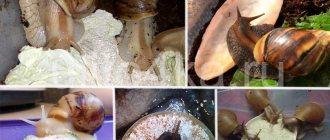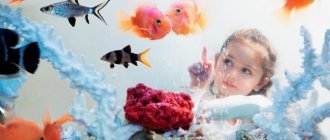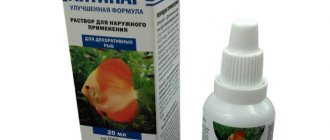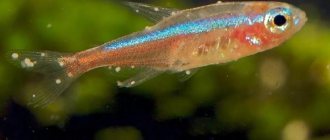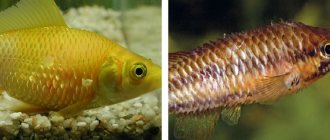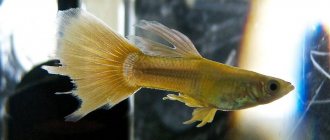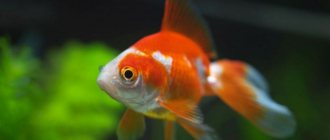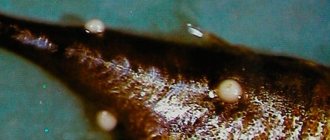Treatment of fish with bicillin 5 in a community aquarium
The proposed method of treatment with Bicillin-5 completely frees fish from the causative agents of the following diseases: ichthyophthyriosis, trichodinosis, chylodonellosis, costiosis, Oodinosis, dactylogyrosis, gyrodactylosis and fin rot, as well as in case of minor damage to fish from fungi of the genera saprolegnia and achlia; promotes the healing of ulcers in mycobacteriosis, ichthyosporidiosis (ichthyophonosis) and peptic ulcer disease, although it does not completely cure.
Bicillin-5 is a mixture of N, N1-dibenzylethylenediamine (1,200,000 units) and novocaine (300,000 units) benzylpenicillin salts. White powder, odorless and tasteless, poorly soluble in water (0.32 mg/ml at -t-28°). The drug is low-toxic and does not have cumulative properties. With water it forms a homogeneous suspension, showing the most active effect in the first two hours after dilution. In bright light it decomposes quickly.
Sick fish, soil and aquatic vegetation are left in the aquarium, but it must be sanitized. Remove dying leaves of plants, fish excrement, food residues, etc. The water temperature is raised to 24-26 and maintained at this level until the end of the course of treatment.
Water hardness and pH do not affect the medicinal properties of the drug.
Every day for six days, a solution of bicillin-5 is added to the aquarium at a concentration of 500,000 units (units of action) per 100 liters of water.
Since the drug is low-toxic, it is possible to divide the contents of the bottle by eye into three equal parts, one of which will correspond to 500,000 units of antibiotic. In a clean container (glass, cup) with a capacity of 200-250 ml, quickly but carefully dilute the amount of bicillin-5 required for the given volume of the aquarium (mother solution) and immediately add it to the aquarium with sick fish. The temperature of the water in the container where the antibiotic is diluted should be 28C. To quickly and evenly distribute the mother solution in the aquarium water, turn on the aeration unit or thoroughly mix the water manually (with a net, wooden or glass rod). Only freshly prepared antibiotic solution is used daily.
The milky color of the mother liquor and the cloudy medicinal solution in the aquarium should not confuse aquarists. After a few hours, the water in the aquarium becomes clearer than it was before adding the stock solution of bicillin-5.
It is better to add the stock solution of bicillin-5 to the aquarium at night. When introduced during the day, the aquarium is shaded for 2 hours.
Treatment of all aquarium fish without exception can begin from the age of two months, without fear of poisoning.
During treatment, fish are fed only with live crustaceans and invertebrate aquatic organisms. Food is given to the fish no earlier than 2 hours after adding the antibiotic solution to the aquarium. If the aquarium is equipped with an aeration unit and filters, they are not turned off.
At the end of the course of fish treatment, the water in the aquarium is not changed. Separate fish farming equipment and fishing gear (feeder, thermometer, sprayers, hoses, net, etc.) are assigned to the aquarium. Fish of the genus Carassius and some species of other genera, for example Phalloceros, at a water temperature of 24-26° will show signs of asphyxia (oxygen starvation), since in such warm water the content of dissolved oxygen is slightly reduced. These fish require intensive water aeration.
Other interesting articles
- Varieties of aquarium fish The number of varieties of aquarium fish is in the thousands, and each of them has its own characteristics. Agile and...
- Treatment of semolina in aquarium fish in a general aquarium Semolina or ichthyophthyriosis is a specific fish disease that has an infectious nature and is caused by…
- Does loud music affect fish in an aquarium? Aquarium fish are rightfully considered one of the most delicate and vulnerable pets. Their calm...
Nosological classification (ICD-10)
- A38 Scarlet fever
- A46 Erysipelas
- A53.9 Syphilis, unspecified
- A66 Yaws
- B55.9 Leishmaniasis, unspecified
- I00 Rheumatic fever without mention of cardiac involvement
- I01 Rheumatic fever with cardiac involvement
- I05-I09 Chronic rheumatic heart disease
- J03.9 Acute tonsillitis, unspecified (angina agranulocytic)
- M79.0 Rheumatism, unspecified
- N74.2 Inflammatory diseases of the female pelvic organs caused by syphilis (A51.4+, A52.7+)
- T79.3 Post-traumatic wound infection, not elsewhere classified
Treatment methods
Sick fish can be treated in a general aquarium (small dose of drugs and long-term treatment: from 6 days to a month), in a separate vessel (significant concentration of drugs, but for a short time: from several minutes to several days, as well as with the help of individual treatment lotions. Treatment in a general or quarantine aquarium (we recommend transplanting fish from a general aquarium into a quarantine aquarium and treating there). A concentrated treatment solution is prepared in a 200-250 ml vessel and poured (in a gentle stream) into the aquarium in 3 doses with an interval of 30 minutes , turning on weak aeration for faster mixing of the solution. The filter is turned off during treatment. Treatment is carried out until the fish are completely recovered.
Treatment in a separate vessel (short-term baths)
Four vessels are used: a quarantine aquarium, a vessel in which the medicinal drug is prepared, a vessel in which the treatment is carried out, and an intermediate vessel. When treated in a separate vessel, the fish are transplanted into a quarantine aquarium. Then, in a 200-250 ml vessel, a concentrated medicinal solution is prepared, calculated for the volume of the vessel in which the treatment is carried out. Then half of the concentrated solution is poured into the vessel in which the treatment is carried out, and the fish is transplanted, turning on weak aeration. Then, over the course of 4-5 minutes, add the remaining solution (not with a strong stream), carefully monitoring the condition of the fish. If they begin to show anxiety, they add water, thereby reducing the concentration of the treatment solution. After the end of the treatment session (the time depends on the chosen drug), the fish are transferred to an intermediate vessel in which the live parasites leave the fish. After 30 minutes, the fish are transferred back to the quarantine aquarium, where they are fed only with live food. After each treatment session, a new medicinal preparation is prepared, disinfected and fresh water is poured into the vessel in which the treatment and the intermediate vessel are carried out. The nets and all equipment used are disinfected after each treatment session. When treating juveniles, the concentration of medicinal drugs is reduced by 1.5-2 times. Treatment in a separate vessel is used against costiosis, chylodenellosis, ichthyophthyriosis, oodinumosis, trichodinosis, gyrodactylosis, dactylogyrosis, lerneosis, argulosis, dermatomycosis, as well as against fish leech (piscicol). For the treatment of infectious diseases, the use of short-term baths is ineffective in most cases.
Lotions
It is used for argulosis and lerneosis, when treatment in baths does not help, as well as for treating wounds for injuries and combating saprolegnia fungi. Place a cotton swab 2-3 times the length of the fish in a vessel with fresh water corresponding to the temperature of the aquarium water. After it is saturated with water, the fish is carefully placed in it, so that only the areas to be processed remain open. Then a wooden stick or match (without a head) with cotton wool wrapped in it is dipped into a pre-prepared solution of potassium permanganate or trypaflavin and applied to the affected areas 3-4 times (the solution should not get on the gills), after which the fish is allowed into the aquarium. The fish is treated every 12 hours until cured. Therapeutic solution, etc., is prepared before each operation. The operation itself should not last more than 1-1.5 minutes. For lotions, use a 0.1% solution of potassium permanganate (1 g of crystalline KMnO4 per 1 liter of water) or a 0.05% aqueous solution of pripaflavin (0.5 g of crystalline trypaflavin per 1 liter of water).
Ultraviolet
Ultraviolet radiation with a wavelength of 200-280 nm destroys nucleic acid molecules in the nuclei of cells and leads to their death. It kills many bacteria, viruses and other microorganisms. The effectiveness of UV irradiation depends on the degree of contamination of the water, the thickness of its layer, the size of the organisms exposed, the intensity of irradiation and its duration.
The dose of radiation received by the body is determined by multiplying the lamp power by the duration of exposure. Typically, the larger the organism, the greater the lethal dose. For example, the lethal dose for single-celled organisms with radiation with a wavelength of about 250 nm is 1 W/s, for protozoa and highly resistant fungi it is 10 times less, for bacteria and other fungi it is 70 times less and for viruses it is 300 times less.
The advisability of installing UV lamps above the aquarium is still unclear. The effectiveness of irradiation is greatly reduced due to the absorption of rays by water. On the other hand, beneficial bacteria in the soil are not irradiated, and the rest of the inhabitants of the aquarium receive only a small dose. The effects of UV rays on fish are also unclear. On the one hand, it is impossible to exclude the possibility that they will go blind, on the other hand, skin parasites die and abrasions and wounds in which bacteria have settled are cleaned.
Therefore, a UV sterilizer is used by installing it outside the aquarium after filters for mechanical and biological water purification. Because Each filter contains a more or less large number of bacteria, and among them there can be all kinds of microorganisms and pathogens, then this method can prevent them from entering the aquarium, because if the water flow rate is correctly selected, providing the required radiation dose, they will die in the sterilizer. But UV irradiation does not have a therapeutic effect when the disease occurs.
The UV sterilizer consists of a UV lamp (type BUV-15, etc.) (1), enclosed in a casing (2) made of quartz glass and a housing (3) with inlet and outlet pipes. Over time, the outer surface of the casing becomes covered with deposits of mineral salts and these should be removed with hydrochloric acid.
Less effective, but simpler is the so-called surface irradiator, consisting of a UV lamp with a reflector installed at a height of 10-20 cm above a shallow trench through which water is passed, and its layer should not exceed 5-6 cm, because at a depth of 10 cm the rays no longer work.
Pharmacokinetics
When administered intramuscularly, bicillin-1 is slowly absorbed, hydrolyzed to release benzylpenicillin, and enters the bloodstream over a long period of time. Cmax is reached within 12–24 hours, therapeutic concentration is achieved within 3–6 hours.
Bicillin-3 after intramuscular administration is slowly hydrolyzed to release benzylpenicillin. With a single injection, the therapeutic concentration in the blood is maintained for 6–7 days, Cmax is achieved 12–24 hours after injection. On the 14th day after administration at a dose of 2.4 million units, the serum concentration is 0.12 mcg/ml, on the 21st day after administration of 1.2 million units - 0.06 mcg/ml (1 unit = 0. 6 mcg). Binding to blood proteins is 40–60%. Penetration into liquids is high, into tissues low. Passes through the placental barrier and enters breast milk. It is biotransformed to a small extent and is excreted mainly by the kidneys.
With the intramuscular administration of Bicillin-5, high concentrations in the blood are created already in the first hours after the injection. After administration of 1.2–1.5 million units in most patients (adults and children), the therapeutic concentration in plasma (0.3 units/ml) persists for 28 days or more.
Interaction
Bactericidal antibiotics (including cephalosporins, cycloserine, vancomycin, rifampicin, aminoglycosides) have a synergistic effect, bacteriostatic (including macrolides, chloramphenicol, lincosamides, tetracyclines) have an antagonistic effect. Reduces the effectiveness of oral contraceptives and ethinyl estradiol (risk of breakthrough bleeding). Diuretics, allopurinol, phenylbutazone, NSAIDs reduce tubular secretion and increase concentration. Allopurinol increases the risk of allergic reactions (skin rash).
Pharmacodynamics
Active against gram-positive microorganisms, incl. Staphylococcus spp. (except for strains that produce penicillinase), Streptococcus spp. (including Streptococcus pneumoniae), Corynebacterium diphtheriae, anaerobic spore-forming bacilli Bacillus anthracis, some gram-negative microorganisms (including Neisseria gonorrhoeae, Neisseria meningitidis), Actinomyces israelii, as well as Treponema spp. Not effective against viruses (causative agents of influenza, polio, smallpox, etc.), mycobacterium tuberculosis, protozoa, rickettsia, fungi, as well as most gram-negative microorganisms.
Precautionary measures
If blood appears in the syringe during an intramuscular injection (indicating that the needle has entered a blood vessel), the syringe should be removed and injected elsewhere. At the end of the injection, the injection site is pressed with a cotton swab, which prevents the drug from entering the muscle tissue into the subcutaneous tissue (rubbing the buttock after the injection is not recommended).
If an allergic reaction develops, treatment is stopped immediately. When the first signs of anaphylactic shock appear, it is necessary to take urgent measures to remove the patient from this state: administration of norepinephrine, glucocorticoids, etc., and, if necessary, mechanical ventilation.
When treating sexually transmitted diseases, if syphilis is suspected, microscopic and serological studies are necessary before starting therapy and then for 4 months.
Due to the possibility of developing fungal infections, it is advisable to prescribe B vitamins and vitamin C, and, if necessary, nystatin and levorin. It must be taken into account that using the drug in insufficient doses or stopping treatment too early often leads to the emergence of resistant strains of pathogens.
